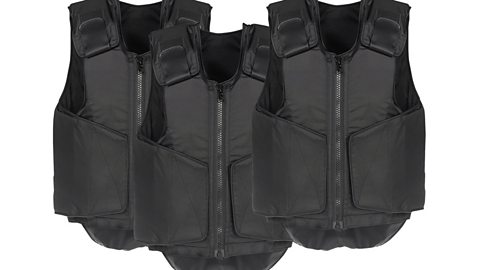Technical textiles
Textiles have come a long way since the early days of cotton and silk, and todayтАЩs modern textiles have some very advanced and useful propertiesThe mechanical, physical or optical properties of materials that define how they behave in use..
A major advance in textiles technology was the invention of polyamide, more commonly known as nylonA thermoplastic that can be made into fibres for clothing, films for food packaging or shaped for electrical equipment.. This syntheticA material made by a chemical process, not naturally occurring. material can be pulled into very thin strands when heated and spunTo make (yarn) by drawing out, twisting, and winding fibres. just like natural textiles, and is now used extensively as a fabric in clothing.
Modern textiles can be engineered to have numerous properties, such as additional strength or resistance to fire, water and even dirt and can be called smart textiles.
conductive fabricA textile material that allows electrical charge to flow through. allow a small electrical current to safely pass through them. This technology is used to dissipate static charge or for touch-screen gloves, which allow a small amount of charge to flow through the glove to connect to the screen.

Interactive textiles allow small electronic components such as batteries or lights to be embedded inside them and can then function as an electronic device or sensor. These include circuits that can be integrated into fabrics, such as heart rate monitors. When used in biometricsAuthentication techniques that rely on measurable physical characteristics (eg fingerprint or iris) that can be automatically checked., the new technology can help collect body measurements and calculations.
fire-retardant fabricA textile material that is resistant to fire. are textiles that are more resistant to fire than others, through chemical treatment or manufactured fireproof fibres. They are often used in furniture and furnishings where fire safety is paramount.
NomexA flame-resistant material to protect from the intense heat of flames, worn by firefighters and racing car drivers. is a flame-resistant material. As it withstands the intense heat of flames, it is worn by firefighters and Formula 1 racing car drivers for protection.

KevlarKevlar (poly-paraphenylene terephthalamide) is a strong, lightweight material that has high tensile strength-to-weight ratio. is a tightly woven fabric that has great impact resistance. It is used in racing tyres, racing sails, gardening gloves and bulletproof vests.

microfibresVery fine fibres of fabric that are thinner than human hair. are much thinner than human hairs and can be coiled to provide a very warm, soft or absorbent material that can be used in winter clothes or products such as cleaning cloths.
microencapsulationA process in which tiny particles or droplets are surrounded by a coating to make small capsules. involves encapsulating liquid or solid substances in tiny thin-walled bubbles. These microsphereA microscopic hollow sphere, especially of a protein or synthetic polymer. gradually release active agents when rubbed, which rupture the thin-walled membraneA thin, pliable sheet of material forming a barrier or lining.. This can bring benefits such as smelling good to cover body odours in sports clothing. A similar technology is used in the scratch and sniff perfume and aftershave samples in magazines. Microencapsulation in fibres can help to absorb, store and release body heat, keeping the user more comfortable. It is also used in ski wear, military uniforms, gloves and footwear for other purposes, for example:
- fragrances added to socks to disguise smelly feet
- anti-allergen chemicals added to bedding to prevent irritation
RhovylAn antibacterial material that has antibacterial agents integrated into┬аthe┬аfibre┬аitself to prevent the formation of bacteria. is an antibacterial material that has antibacterial agents integrated into the fibre itself. This prevents the formation of bacteria and does not wash out. It is used in bedding, childrenтАЩs clothes, sportswear and underwear, and has many properties:
- thermal insulation and natural fire retardancy
- wicks away moisture
- resistant to mildew, fungi and chemicals
Since the development of syntheticA material made by a chemical process, not naturally occurring. fibres, there have been numerous improvements in textiles technology, and new variations are constantly being produced. Like other engineered modern materials, properties can be combined or enhanced, so if you want something to be fire and water resistant while also being conductorA material which allows charge to move easily through it., textiles can be engineered to meet those needs.